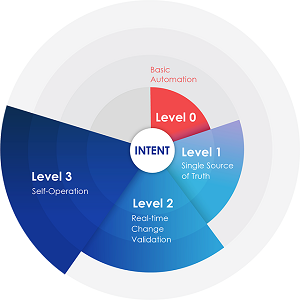News
Apstra Offers Intent-Based Networking Taxonomy and Maturity Model
Intent-based networking (IBN) pioneer Apstra has offered up a taxonomy and maturity model for the young, game-changing technology, described by many as the next big thing in the networking industry.
The model seeks to objectively define maturity levels of IBN implementations, Apstra said, in order to help network operators evaluate solutions with a standardized approach that cuts through marketing hype.
Marketing hype around IBN has grown since IBN burst onto the scene several years ago, pioneered by companies such as Apstra. Networking giant Cisco Systems last year announced that IBN would guide its future direction as it shifted from hardware-centric to software-driven networking, declaring it the company's "biggest innovation in the past decade."
Research firms have jumped on the bandwagon also, with Gartner saying IBN promises to be "the next big thing on the networking horizon."
IBN provides a declarative approach to networking, letting operators describe a desired outcome -- the "what" -- as opposed to "how" to achieve an outcome, leveraging advanced technologies such as machine learning and automation to enact the "what."
"And the desired outcome is complete automation of the whole network service lifecycle, which consists of the following phases: design, build, deploy, validate," Apstra says.
 [Click on image for larger view.] Apstra's IBN Maturity Model (source: Apsra).
[Click on image for larger view.] Apstra's IBN Maturity Model (source: Apsra).
To organize and further the IBN movement, Apstra last week introduced its model to simplify the evaluation of datacenter network automation options. It consists of four levels, 0 (basic automation) through 4 (IBN).
"We are introducing a model intended to help CTOs and network operators evaluate and differentiate the maturity of IBN solutions with an objective set of criteria, beginning with Level 0 (low maturity/incomplete) offerings going up to Level 3 (mature/complete) offerings which enable companies to leverage full benefits of IBN approach," said Sasha Ratkovic, CTO and founder of Apstra, in a statement.
Ratkovic explains more in a blog post, where he says level 1 implementations provide a "single source of truth" that contains both the intent and the network operational state, including data and state artifacts related to the four aspects of a network service lifecycle: design, build, deploy and validate.
That precedes level 2, which addresses real-time change validation that an intent is actually met.
Level 3, meanwhile, shows self-operation: "doing something about what is being observed, if and when it is applicable. This ultimate level requires corrective actions and takes IBN on a path to self-operating networks."
About the Author
David Ramel is an editor and writer at Converge 360.